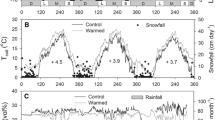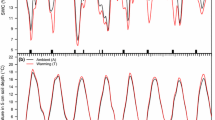Abstract
Climatic warming will probably have particularly large impacts on carbon fluxes in high altitude and latitude ecosystems due to their great stocks of labile soil C and high temperature sensitivity. At the alpine treeline, we experimentally warmed undisturbed soils by 4 K for one growing season with heating cables at the soil surface and measured the response of net C uptake by plants, of soil respiration, and of leaching of dissolved organic carbon (DOC). Soil warming increased soil CO2 effluxes instantaneously and throughout the whole vegetation period (+45%; +120 g C m y−1). In contrast, DOC leaching showed a negligible response of a 5% increase (NS). Annual C uptake of new shoots was not significantly affected by elevated soil temperatures, with a 17, 12, and 14% increase for larch, pine, and dwarf shrubs, respectively, resulting in an overall increase in net C uptake by plants of 20–40 g C m−2y−1. The Q 10 of 3.0 measured for soil respiration did not change compared to a 3-year period before the warming treatment started, suggesting little impact of warming-induced lower soil moisture (−15% relative decrease) or increased soil C losses. The fraction of recent plant-derived C in soil respired CO2 from warmed soils was smaller than that from control soils (25 vs. 40% of total C respired), which implies that the warming-induced increase in soil CO2 efflux resulted mainly from mineralization of older SOM rather than from stimulated root respiration. In summary, one season of 4 K soil warming, representative of hot years, led to C losses from the studied alpine treeline ecosystem by increasing SOM decomposition more than C gains through plant growth.







Similar content being viewed by others
References
Bednorz F, Reichstein M, Broll G et al (2000) Humus forms in the forest-alpine tundra ecotone at Stillberg (Dischmatal, Switzerland): spatial heterogeneity and classification. Arct Antarct Alp Res 32:21–29. doi:10.2307/1552406
Bernoulli M, Körner C (1999) Dry matter allocation in treeline trees. Phyton 39:7–12
Bronson DR, Gower ST, Tanner M et al (2008) Response of soil surface CO2 flux in a boreal forest to ecosystem warming. Glob Change Biol 14:856–867. doi:10.1111/j.1365-2486.2007.01508.x
Christ MJ, David MB (1996) Temperature and moisture effects on the production of dissolved organic carbon in a Spodosol. Soil Biol Biochem 28:1191–1199. doi:10.1016/0038-0717(96)00120-4
Ciais P, Reichstein M, Viovy N (2005) Europe-wide reduction in primary productivity caused by the heat and drought in 2003. Nature 437:529–533. doi:10.1038/nature03972
Danby RK, Hik DS (2007) Responses of white spruce (Piceea glauca) to experimental warming at a subarctic alpine treeline. Glob Change Biol 13:437–451. doi:10.1111/j.1365-2486.2006.01302.x
Davidson EA, Janssens IA (2006) Temperature sensitivity of soil carbon decomposition and feedbacks to climate change. Nature 440:165–173. doi:10.1038/nature04514
Dormann CF, Woodin SJ (2002) Climate change in the Arctic: using plant functional types in a meta-analysis of field experiments. Funct Ecol 16:4–17. doi:10.1046/j.0269-8463.2001.00596.x
Federal Office for Water and Geology (2001) Hydrological atlas of Switzerland, 6th edn. Bern, Switzerland
Fröberg M, Berggren M, Bergkvist B et al (2006) Concentration and fluxes of dissolved organic carbon (DOC) in three Norway spruce stands along a climatic gradient in Sweden. Biogeochem 77:1–23. doi:10.1007/s10533-004-0564-5
Hagedorn F, van Hees PAW, Handa IT et al. (2008) Elevated atmospheric CO2 fuels leaching of old dissolved organic matter at the alpine treeline. Glob Biogeochem Cycles 22:GB2004. doi:10.1029/2007GB003026
Handa TI, Körner C, Hättenschwiler S (2006) Conifer stem growth at the altitudinal treeline in response to four years of CO2 enrichment. Glob Change Biol 12:2417–2430. doi:10.1111/j.1365-2486.2006.01258.x
Handa TI, Hagedorn F, Hättenschwiler S (2008) No stimulation in root production in response to four years of in situ CO2 enrichment at the Swiss treeline. Funct Ecol 22:348–358. doi:10.1111/j.1365-2435.2007.01372.x
Harrison A, Taylor K, Scott A et al (2008) Potential effects climate change on DOC release from three different soil types on the Northern Pennines UK: examination using field manipulation experiments. Glob Change Biol 14:687–702. doi:10.1111/j.1365-2486.2007.01504.x
Hartley AE, Neill C, Melillo JM et al (1999) Plant performance and soil nitrogen mineralization in response to simulated climate change in subarctic dwarf shrub heath. Oikos 86:331–343. doi:10.2307/3546450
Hättenschwiler S, Handa IT, Egli L et al (2002) Atmospheric CO2 enrichment of alpine treeline conifers. New Phytol 156:363–375. doi:10.1046/j.1469-8137.2002.00537.x
Heimann M, Reichstein M (2008) Terrestrial ecosystem carbon dynamics and climate feedbacks. Nature 451:289–292. doi:10.1038/nature06591
Högberg P, Nordgren A, Buchmann N et al (2001) Large-scale forest girdling shows that current photosynthesis drives soil respiration. Nature 411:789–792. doi:10.1038/35081058
IPCC (2007) Climate change 2007: the physical science basis. In: Solomon S, Qin D, Manning M (eds) Contribution of working group I to the fourth assessment report of the intergovernmental panel on climate change. Cambridge University Press, Cambridge
Jenny H (1926) Vegetations-Entwicklung und Bodenbnildung. Zweiter Teil: Die alpinen Böden. Denkschrift Schweizerischen Naturforschenden Ges 63:297–340
Jolly WM, Dobbertin M, Zimmermann NE et al (2005) Divergent vegetation growth responses to the 2003 heat wave in the Swiss Alps. Geophys Res Lett 32:L18409. doi:10.1029/2005GL023252
Joos O, Saurer M, Heim A, et al. (2008) Can we use the CO2 concentrations determined by continuous-flow isotope ratio mass spectrometry from small samples for the Keeling plot approach? Comparison of infrared gas analyser and isotope ratio mass spectrometer measurements. Rapid Commun Mass Spectrom 22:4029–4034
Kalbitz K, Solinger S, Park J-H et al (2000) Controls on the dynamics of dissolved organic carbon in soils: a review. Soil Sci 165:277–304. doi:10.1097/00010694-200004000-00001
Kirschbaum MUF (1995) The temperature dependence of soil organic matter decomposition, and the effect of global warming on soil C storage. Soil Biol Biochem 27:753–760
Körner C (1998) A re-assessment of high elevation treeline positions and their explanation. Oecologia 115:445–459. doi:10.1007/s004420050540
Körner C (2003) Alpine plant life—functional plant ecology of high mountain ecosystems, 2nd edn. Springer, Heidelberg
Kudo G, Suzuki S (2003) Warming effects on growth, production, and vegetation structure of alpine shrubs: a five-year experiment in northern Japan. Oecologia 135:280–287
Luo Y, Shigiang W, Hui D et al (2001) Acclimatization of soil respiration to warming in a tall grass prairie. Nature 413:622–625. doi:10.1038/35098065
Luterbacher J, Dietrich D, Xoplaki E et al (2004) European seasonal and annual temperature variability, trends, and extremes since 1500. Science 303:1499–1503. doi:10.1126/science.1093877
Marschner B, Bredow A (2002) Temperature effects on release and ecologically relevant properties of dissolved organic carbon in sterilised and biologically active soil samples. Soil Biol Biochem 34:459–466
Melillo JM, Steudler PA, Aber JD et al (2002) Soil warming and carbon-cycle feedbacks to the climate system. Science 298:2173–2176. doi:10.1126/science.1074153
Michalzik B, Kalbitz K, Park J-H et al (2001) Fluxes and concentrations of dissolved organic carbon and nitrogen—a synthesis for temperate forests. Biogeochem 52:173–205. doi:10.1023/A:1006441620810
Niinistö SM, Silvola J, Kellomäki S (2004) Soil CO2 efflux in a boreal pine forest under atmospheric CO2 enrichment and air warming. Glob Change Biol 10:1363–1376. doi:10.1111/j.1365-2486.2004.00799.x
Oberbauer S, Tweedie CE, Welker JM et al (2007) Tundra CO2 fluxes in response to experimental warming across latitudinal and moisture gradients. Ecol Monogr 77:221–238. doi:10.1890/06-0649
Oechel WC, Vourlitis GL, Hastings SL et al (1993) Acclimatization of ecosystem CO2 exchange in the Alaskan Arctic in response to decadal climate warming. Nature 406:978–981. doi:10.1038/35023137
Parsons AN, Welker JM, Wookey PA et al (1994) Growth-responses of 4 sub-arctic dwarf shrubs to simulated environmental change. J Ecol 82:307–318. doi:10.2307/2261298
Rebetez M, Reinhard M (2008) Monthly air temperature trends in Switzerland 1901–2000 and 1975–2004. Theor Appl Climatol 91:27–34. doi:10.1007/s00704-007-0296-2
Rebetez M, Doupont O, Giroud M (2009) An analysis of the July 2006 heatwave extent in Europe compared to the record year of 2003. Theor Appl Climatol 95:1–7. doi:10.1007/s00704-007-0370-9
Reichstein M, Bednorz F, Broll G et al (2000) Temperature dependence of carbon mineralization: conclusions from a long-term incubation of subalpine soil samples. Soil Biol Biochem 32:947–958. doi:10.1016/S0038-0717(00)00002-X
Rustad LE, Campbell JL, Marion GM et al (2001) A meta-analysis of the response of soil respiration, net nitrogen mineralization, and aboveground plant growth to experimental ecosystem warming. Oecologia 126:543–562. doi:10.1007/s004420000544
Saleska SR, Harte J, Torn M (1999) The effect of experimental ecosystem warming on CO2 fluxes in a montane meadow. Glob Change Biol 5:125–141. doi:10.1046/j.1365-2486.1999.00216.x
Schindlbacher A, Zechmeister-Boltenstern S, Jandl R (2009) Carbon losses due to soil warming: do autotrophic and heterotrophic soil respiration respond equally? Glob Change Biol 15:901–913. doi:10.1111/j.1365-2486.2008.01757.x
Senn J, Schönenberger W (2001) Zwanzig Jahre Versuchsaufforstung Stillberg: Überleben und Wachstum einer subalpinen Aufforstung in Abhängigkeit vom Standort. Schweiz Z Forstwes 152:226–246
Shaver GR, Chapin FSIII, Gartner BL (1986) Factors limiting seasonal growth and peak biomass accumulation in Eriophorum vaginatum in Alaskan tussock tundra. J Ecol 74:257–278. doi:10.2307/2260362
Sjögersten S, Turner BL, Mathieu N et al (2003) Soil organic matter biochemistry and potential susceptibility to climate change across the forest-tundra ecotone in the Fennoscandian mountains. Glob Change Biol 9:759–772. doi:10.1046/j.1365-2486.2003.00598.x
Stott PA, Stone DA, Allen MR (2004) Human contribution to the European heatwave of 2003. Nature 432:610–614. doi:10.1038/nature03089
Subke J-A, Hahn V, Battipaglia G et al (2004) Feedback interactions between needle litter decomposition and rhizosphere activity. Oecologia 139:551–559. doi:10.1007/s00442-004-1540-4
Vance ED, Brookes PC, Jenkinson DS (1987) An extraction method for measuring soil microbial biomass C. Soil Biol Biochem 19:703–707. doi:10.1016/0038-0717(87)90052-6
Acknowledgments
We thank K. Wetter, A. Moser, M. Pohl, and R. Köchli for their field assistance, N. Hajar for measuring DOC concentrations. The research platform Stillberg was financed by Velux foundation and a French “ANR-biodiversité” grant (project “Qdiv” led by Paul Leadley). M. Martin was supported by the Swiss National Science Foundation (SNF; grant 315200-116861).
Author information
Authors and Affiliations
Corresponding author
Rights and permissions
About this article
Cite this article
Hagedorn, F., Martin, M., Rixen, C. et al. Short-term responses of ecosystem carbon fluxes to experimental soil warming at the Swiss alpine treeline. Biogeochemistry 97, 7–19 (2010). https://doi.org/10.1007/s10533-009-9297-9
Received:
Accepted:
Published:
Issue Date:
DOI: https://doi.org/10.1007/s10533-009-9297-9




